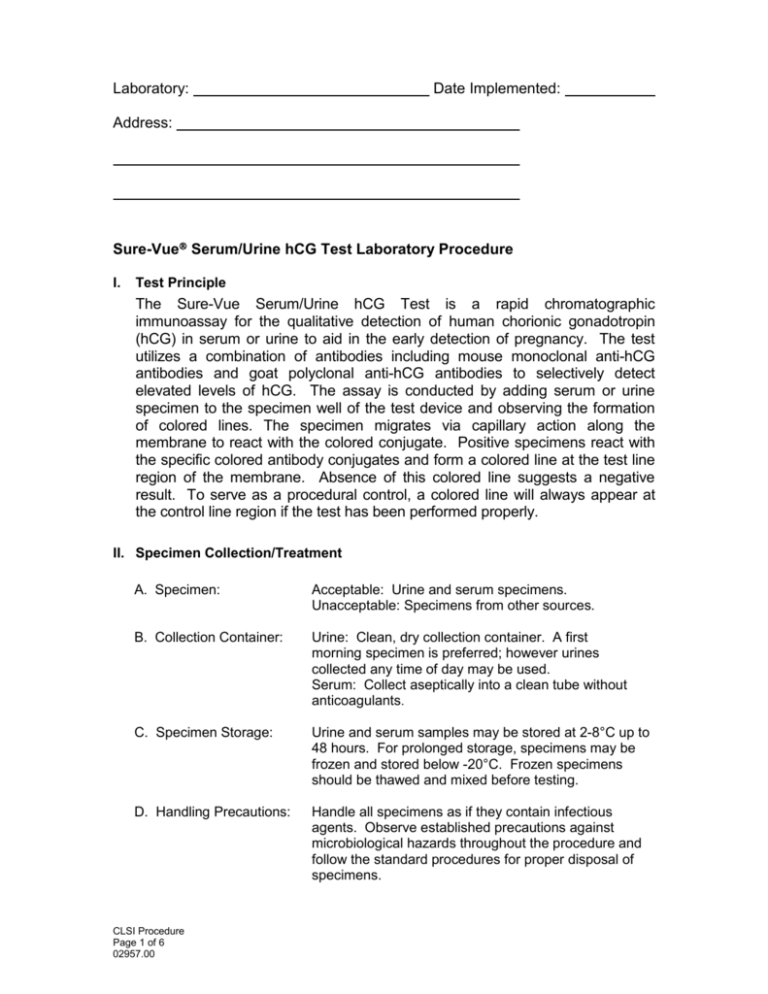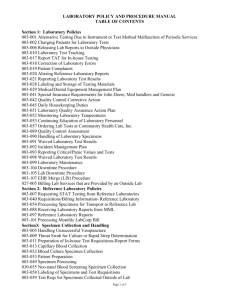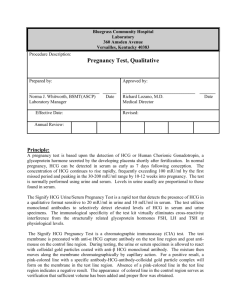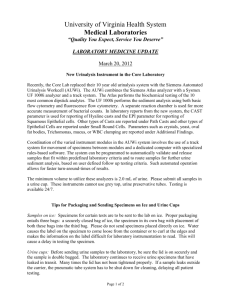
Laboratory:
Date Implemented:
Address:
Sure-Vue Serum/Urine hCG Test Laboratory Procedure
I.
Test Principle
The Sure-Vue Serum/Urine hCG Test is a rapid chromatographic
immunoassay for the qualitative detection of human chorionic gonadotropin
(hCG) in serum or urine to aid in the early detection of pregnancy. The test
utilizes a combination of antibodies including mouse monoclonal anti-hCG
antibodies and goat polyclonal anti-hCG antibodies to selectively detect
elevated levels of hCG. The assay is conducted by adding serum or urine
specimen to the specimen well of the test device and observing the formation
of colored lines. The specimen migrates via capillary action along the
membrane to react with the colored conjugate. Positive specimens react with
the specific colored antibody conjugates and form a colored line at the test line
region of the membrane. Absence of this colored line suggests a negative
result. To serve as a procedural control, a colored line will always appear at
the control line region if the test has been performed properly.
II. Specimen Collection/Treatment
A. Specimen:
Acceptable: Urine and serum specimens.
Unacceptable: Specimens from other sources.
B. Collection Container:
Urine: Clean, dry collection container. A first
morning specimen is preferred; however urines
collected any time of day may be used.
Serum: Collect aseptically into a clean tube without
anticoagulants.
C. Specimen Storage:
Urine and serum samples may be stored at 2-8°C up to
48 hours. For prolonged storage, specimens may be
frozen and stored below -20°C. Frozen specimens
should be thawed and mixed before testing.
D. Handling Precautions:
Handle all specimens as if they contain infectious
agents. Observe established precautions against
microbiological hazards throughout the procedure and
follow the standard procedures for proper disposal of
specimens.
CLSI Procedure
Page 1 of 6
02957.00
III. Reagents and Equipment
A. Reagents and Materials Provided
Test Devices
Disposable specimen droppers
Package insert
B. Materials Required but not Provided
Specimen collection container
Timer
C. Storage and Stability
Store as packaged in the sealed pouch at 2°-30°C. The test device is stable
through the expiration date printed on the sealed pouch. The test device must
remain in the sealed pouch until use. DO NOT FREEZE. Do not use beyond the
expiration date.
D. Quality Control
Internal Procedural Controls
Internal procedural controls are included in the test. A red line appearing in the
control region (C) is the internal procedural control. It confirms sufficient
specimen volume and correct procedural technique. A clear background is an
internal negative background control. If the test is working properly, the
background in the result area should be white to light pink and not interfere with
the ability to read the test result.
External Quality Control Testing
It is recommended that a positive hCG control (containing 25-250 mIU/mL hCG)
and a negative hCG control (containing "0" mIU/mL hCG) be evaluated to verify
proper test performance. It is recommended that federal, state, and local
guidelines be followed.
External Quality Control Testing
Remedial Actions
When correct control results are not obtained, do not report patient results.
Contact Technical Services at 800-637-3717.
E. Precautions
• For professional in vitro diagnostic use only. Do not use after the expiration
date.
• The test device should remain in the sealed pouch until use.
• All specimens should be considered potentially hazardous and handled in the
same manner as an infectious agent.
• The test device should be discarded in a proper biohazard container after
testing.
CLSI Procedure
Page 2 of 6
02957.00
IV. Test Procedure
Specimen Collection and Handling:
To collect urine specimen
A urine specimen must be collected in a clean and dry container.
A first morning urine specimen is preferred since it generally contains the
highest concentration of hCG; however, urine specimens collected at any
time of the day may be used.
Urine specimens exhibiting visible precipitates should be centrifuged, filtered,
or allowed to settle to obtain a clear specimen for testing.
To collect serum specimen
Blood should be collected aseptically into a clean tube without
anticoagulants.
Separate the serum from blood as soon as possible to avoid hemolysis.
Use clear non-hemolyzed specimens when possible.
Serum or urine specimen may be stored at 2-8C for up to 48 hours prior to
testing. For prolonged storage, specimens may be frozen and stored below
-20C. Frozen specimens should be thawed and mixed before testing.
Test Procedure:
Allow the test device, urine, and/or controls to equilibrate to room
temperature (15-30°C) prior to testing.
1. Bring the pouch to room temperature before opening it. Remove the test
device from the sealed pouch and use it as soon as possible.
2. Place the test device on a clean and level surface. Hold the dropper vertically
and transfer 3 full drops of serum or urine (approx. 100µl) to the specimen
well of the test device, and then start the timer. Avoid trapping air bubbles in
the specimen well.
3. Wait for the red line(s) to appear. Read the result at 3 minutes when testing
a urine specimen, or at 5 minutes when testing a serum specimen. It is
important that the background is clear before the result is read.
Note: A low hCG concentration might result in a weak line appearing in the test
region (T) after an extended period of time; therefore, do not interpret the result
after 10 minutes.
V.
Interpretation of Test Results
POSITIVE:* Two distinct red lines appear. One line should be in the control
region (C) and another line should be in the test region (T).
*NOTE: The intensity of the red color in the test line region (T) will vary
depending on the concentration of hCG present in the specimen. However,
neither the quantitative value nor the rate of increase in hCG can be determined
by this qualitative test.
NEGATIVE: One red line appears in the control region (C). No apparent red or
pink line appears in the test region (T).
INVALID: Control line fails to appear. Insufficient specimen volume or incorrect
procedural techniques are the most likely reasons for control line failure. Review
CLSI Procedure
Page 3 of 6
02957.00
the procedure and repeat the test with a new test device. If the problem persists,
discontinue using the test kit immediately and contact Technical Support at (800)
637-3717.
VI.
Limitations
1. Very dilute urine specimens, as indicated by a low specific gravity, may not
contain representative levels of hCG. If pregnancy is still suspected, a first
morning urine specimen should be collected 48 hours later and tested.
2. False negative results may occur when the levels of hCG are below the
sensitivity level of the test. When pregnancy is still suspected, a first morning
serum or urine specimen should be collected 48 hours later and tested.
3. Very low levels of hCG (less than 50 mIU/mL) are present in urine and serum
specimen shortly after implantation. However, because a significant number
of first trimester pregnancies terminate for natural reasons, 5 a test result that
is weakly positive should be confirmed by retesting with a first morning serum
or urine specimen collected 48 hours later.
4. A number of conditions other than pregnancy, including trophoblastic disease
and certain non-trophoblastic neoplasms including testicular tumors, prostate
cancer, breast cancer, and lung cancer, cause elevated levels of hCG.6,7
Therefore, the presence of hCG in serum or urine specimen should not be
used to diagnose pregnancy unless these conditions have been ruled out.
5. As with any assay employing mouse antibodies, the possibility exists for
interference by human anti-mouse antibodies (HAMA) in the specimen.
Specimens from patients who have received preparations for monoclonal
antibodies for diagnosis or therapy may contain HAMA. Such specimens
may cause false positive or false negative results.
6. This test provides a presumptive diagnosis for pregnancy. A confirmed
pregnancy diagnosis should only be made by a physician after all clinical and
laboratory findings have been evaluated.
VII.
Expected Values
Negative results are expected in healthy non-pregnant women and healthy men.
Healthy pregnant women have hCG present in their urine and serum specimens.
The amount of hCG will vary greatly with gestational age and between individuals.
The Sure-Vue Serum/Urine hCG has a sensitivity of 25 mIU/mL, and is capable of
detecting pregnancy as early as 1 day after the first missed menses.
VIII.
Performance Characteristics
Accuracy
A multi-center clinical evaluation was conducted comparing the results obtained
using the Sure-Vue Serum/Urine hCG to another commercially available serum/urine
membrane hCG test. The urine study included 159 specimens and both assays
identified 88 negative and 71 positive results. The serum study included 73
specimens and both assays identified 51 negative and 21 positive and 1 inconclusive
results. The results demonstrated a 100% overall agreement (for an accuracy of
>99%) of the Sure-Vue Serum/Urine hCG when compared to the other urine/serum
membrane hCG test.
CLSI Procedure
Page 4 of 6
02957.00
Sensitivity and Specificity
The Sure-Vue Serum/Urine hCG detects hCG at a concentration of 25 mIU/mL or
greater. The test has been standardized to the W.H.O. Third International Standard.
The addition of LH (300 mIU/mL), FSH (1,000 mIU/mL), and TSH (1,000 µIU/mL) to
negative (0 mIU/mL hCG) and positive (25 mIU/mL hCG) specimens showed no
cross-reactivity.
Interfering Substances
The following potentially interfering substances were added to hCG negative and
positive specimens.
Acetaminophen
Acetylsalicylic Acid
Ascorbic Acid
Atropine
Bilirubin (serum)
Triglycerides (serum)
20 mg/mL
20 mg/mL
20 mg/mL
20 mg/mL
40 mg/dL
1200mg/dL
Caffeine
Gentisic Acid
Glucose
Hemoglobin
Bilirubin (urine)
20 mg/mL
20 mg/mL
2 g/dL
1 mg/dL
2 mg/dL
None of the substances at the concentration tested interfered in the assay.
IX.
References
1. Batzer FR. “Hormonal evaluation of early pregnancy.” Fertil. Steril. 1980; 34(1):
1-13
2. Catt KJ, ML Dufau, JL Vaitukaitis. “Appearance of hCG in pregnancy plasma
following the initiation of implantation of the blastocyte.” J. Clin. Endocrinol.
Metab. 1975; 40(3): 537-540
3. Braunstein GD, J Rasor, H. Danzer, D Adler, ME Wade. “Serum human chorionic
gonadotropin levels throughout normal pregnancy.” Am. J. Obstet. Gynecol.
1976; 126(6): 678-681
4. Lenton EA, LM Neal, R Sulaiman. “Plasma concentration of human chorionic
gonadotropin from the time of implantation until the second week of pregnancy.”
Fertil. Steril. 1982; 37(6): 773-778
5. Steier JA, P Bergsjo, OL Myking. “Human chorionic gonadotropin in maternal
plasma after induced abortion, spontaneous abortion and removed ectopic
pregnancy.” Obstet. Gynecol. 1984; 64(3): 391-394
6. Dawood MY, BB Saxena, R Landesman. “Human chorionic gonadotropin and its
subunits in hydatidiform mole and choriocarcinoma.” Obstet. Gynecol. 1977;
50(2): 172-181
7. Braunstein GD, JL Vaitukaitis, PP Carbone, GT Ross. “Ectopic production of
human chorionic gonadotropin by neoplasms.” Ann. Intern Med. 1973; 78(1): 3945
8. Sure-Vue Serum/Urine hCG Package Insert
Sure-Vue® is a registered trademark of Fisher Scientific Company, L.L.C. All rights
reserved.
CLSI Procedure
Page 5 of 6
02957.00
Test Procedure Review
Supervisor
CLSI Procedure
Page 6 of 6
02957.00
Date Reviewed
Supervisor
Date Reviewed







